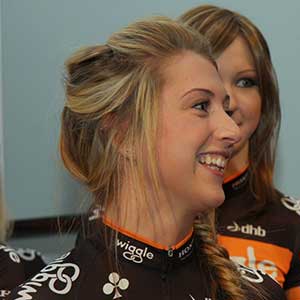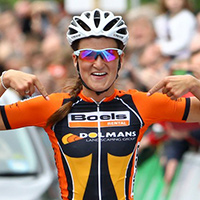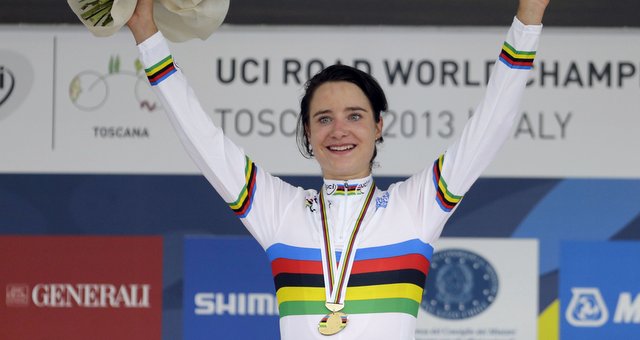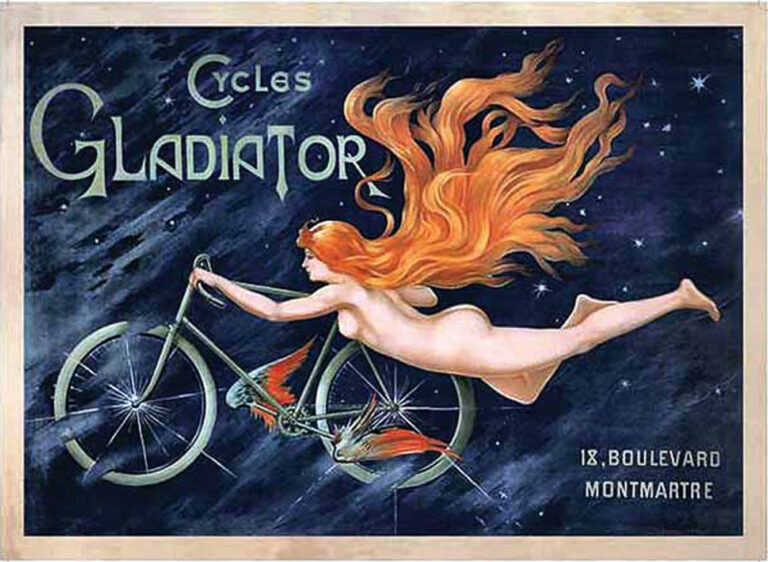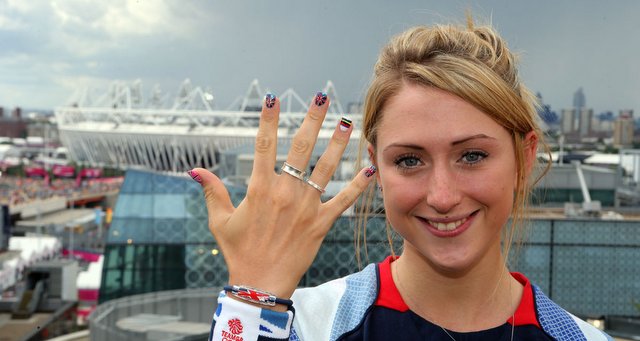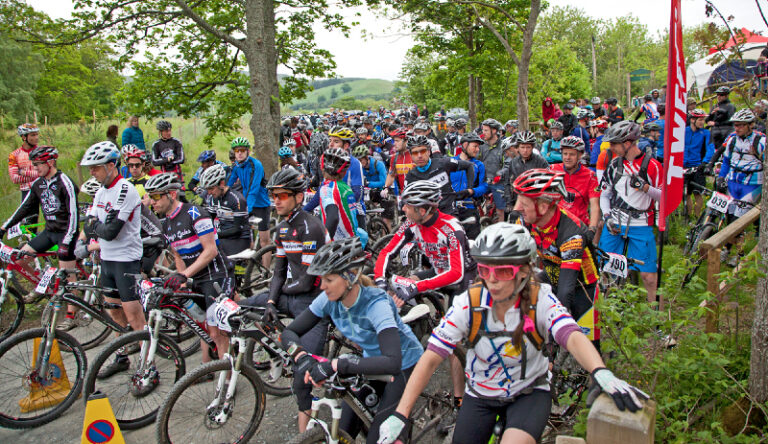In April there was a lot of discussion, as there always is around the big races, about why we couldn’t watch Marianne Vos winning the Ronde van Vlaanderen. A thrilling race, with tantalising clips appearing afterwards showcasing a four-woman battle right to the end. Just the kind of exciting racing that would bring new fans to the sport in droves.

Our race commentator, Sarah Connolly, takes an in depth look at pro-women’s road cycling, the lack of televised coverage and how we can help to change things.
It’s always a mystery as to why women’s road cycling isn’t shown on television. The format suits TV a lot better than the men’s races do. The UCI has put strict limitations on how far the women’s peloton are allowed to race. To illustrate, the women’s Olympic Road Race had to be 120-140km, while the men’s could be up to 250-280km. The maximum a single stage can be in a tour is 240km for the men and just 130km for the women.
While the reasoning for the shorter races can be endlessly debated, the result is that the women end up with a lot more energy to race with. Add this to the fact that women’s teams are limited to 6 riders, it certainly makes for interesting viewing.
We saw this with the Olympic Games, where the men rode together en peloton until they got to Box Hill. The action didn’t truly start until a couple of laps in, while the women attacked from the start.
Ellen van Dijk and Loes Gunnewijk taking it in turns to attack again and again, forcing other teams to chase. As soon as they got to the hills, Marianne Vos and Emma Pooley took over, attacking like crazy until the nail-biting finale in the pouring rain.
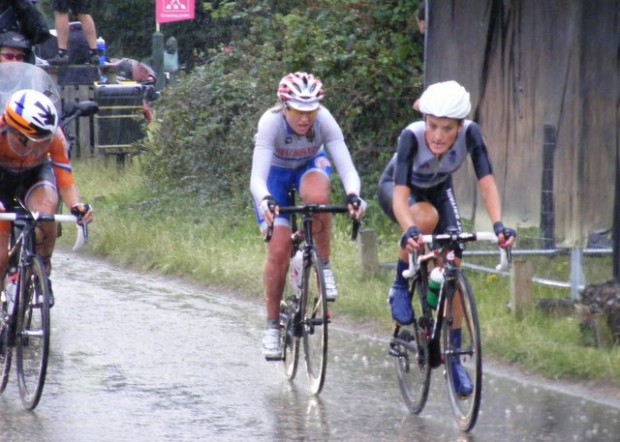
This is typical of women’s racing, when people get the chance to see it, they love it and the statistics prove it. At the Olympics, the BBC’s men’s road race had a peak audience of 2.2 million – while the peak figure for the women was 7.6 million. Further more, the figures were similar for Eurosport, which puts the argument that “women’s racing isn’t shown because people aren’t interested” in a rather interesting light.
It’s not even as though women’s cycling is asking for every race to be shown in full. Of course we’d love to see the whole of the women’s Ronde van Vlaanderen or Flèche Wallone, when it’s raced on 18th April, but we’d settle for the cameras moving from the men’s race to show the finish of the women’s, as they used to do a few years ago.
In both of these races, the courses are designed so that the women hit the important places, and especially the final run-in to the finish, while the men are riding some boring corner of the race where nothing happens.
In 2010, the coverage of the Flèche Wallonne cut to show the women’s finale. It made perfect sense, while the women were finishing on the devastating Mur de Huy an impossibly hard climb, the men’s race had hit a lull. The video above shows the women competing in the 2012 race, pushing through the pain up the Mur de Huy to cross the finish line. So why isn’t this common practice?
For those purists who worry a moment of the men’s race could be missed, why not show the race in split-screens? The technology has been there for decades, and it’s common practice to show the breakaway and the chase group, or a dull part of the race split-screened with interviews. What’s stopping the women’s races being shown alongside the men’s, when they’re on the same course?
It’s really hard not to say “sexism” here – and if not sexism, then apathy or lack of imagination, but it’s very easy to fix, too. The races are filmed by one TV company, who sell the rights around the world. Therefore Eurosport for example can only show what they’re given.
Companies like Eurosport could complain to the host broadcaster or better yet, the races, who sell the rights to the broadcasters, stipulating in the contracts that the broadcasters can only show the men’s race if they show a certain amount of the women’s race.
This could potentially be mandated by the UCI, too, by adding a line into the requirements for races having World Tour status. It’s incredibly simple, making it all the harder to understand why it doesn’t happen.
Of course that only counts for races where the women race alongside the men. The majority of the women’s races are stand-alone. Here, the frustrations are different, practically every women’s race is filmed, all the way through, but it can be hard to know how to see that footage, without knowing where to look.
The Netherlands and Italy lead the way on showing women’s racing. The first two rounds of the Road World Cup, the important season-long series of day races, were both shown on TV, because of the countries they were in. The Trofeo Alfredo Binda had an hour-long highlights programme on Italian station RAI Sport 2, on TV and online.
When it comes to the biggest women’s stage race of the year, the Giro Donne, RAI show an hour highlights programme of every stage, after their Tour de France coverage. The last 20 minutes of the Ronde van Drenthe was shown on local Dutch station, RTV Drenthe, and un-geo-restricted on their website.
It’s no wonder the Dutch and the Italians dominate the women’s peloton, because there, sport is taken seriously.
Girls can grow up watching cycling heroines.
The Netherlands is especially good at this. Throughout last week, there was the flat, tough, sprinty Energiewacht Tour. Every evening there was a short highlights programme shown on local channel RTL7, and then hosted online, un-geo-restricted, on the Energiewacht Tour page of their website, RTL XL.
It’s a really friendly race, with great social media presence. Even if you don’t understand Dutch, it was incredibly easy to follow. This race, and the Ladies Tour of Qatar, which was shown live online on Al Jazeera, pull in new fans who love the attacking, aggressive way the women race in the wind.
If you want to see more women’s cycling, what can you do about it?
The Internet is awash with websites that can help. The race websites will usually link to any coverage, and fan sites, like Podium Café’s women’s cycling section, or my own website, Prowomenscycling.com, are happy to point people to any coverage we see. Then there are sites that collect video. I always use the Cycling Fever video pages to see what I’ve missed, and their race pages have links to any video they’ve found on YouTube.
It’s not all bad news things are truly getting better. Last year, the UCI commissioned David Harmon’s production company to make 15-minute programmes of each of the Road World Cup races. These were to be for the UCI’s YouTube channel, and to be shown on TV stations around the world.
This year they’ve added highlights of each race, uploaded on the evening of the race, all commentated by Harmon, in English – with some features that will be filmed later in the year.
These are all baby steps – but on the other side, they now stream the track, cyclocross and BMX World Cup races live on their Youtube, along with all the World Championships, including road, with no difference between their men’s and women’s coverage. Hopefully they will increase their road coverage too.
There are things we can do as fans too. Email and the Internet make it easy to share our opinions. We can ask the UCI what they’re doing to help more women’s racing be seen. For those of us in the UK, we can ask British Cycling what pressure they’re putting on the UCI about it and our favourite broadcasters, too.
The bottom line is this; women’s racing is exciting, and every time it’s shown, it wins hundreds if not thousands of new fans.
The arguments of “we won’t show it because no one will watch” just don’t fly – try it, and see if there’s proof. Once it’s on TV, or streamed online, sponsors will have a reason to support the sport, fans will be happy, and all the little girls dreaming of growing up to be the next Laura Trott, Lizzie Armitstead or Marianne Vos will be able to watch their heroines – and anything that inspires anyone to get on a bike and give it a go has to be worthwhile.
To see the UCI’s coverage of all forms of cycling, head to their Youtube channel – and this playlist has some of the videos from the 2010 and 2011 World Cup.If any questions have sprouted from reading this article, feel free to ask below. Alternatively contact Sarah with questions about following races at [email protected], or on twitter at @_pigeons_
Headline image from the 2012 Olympic road race, courtesy of Mr Honeybun, via Flickr

